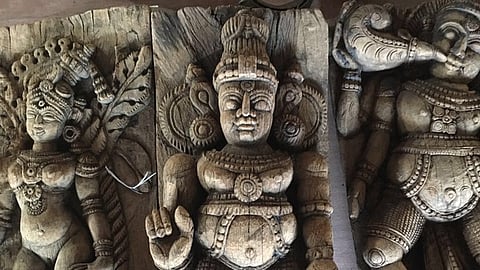

In the budget session of Parliament this year, Culture Minister Mahesh Sharma diligently recited the work of the country’s many idol wings in a laudatory tone - particularly in Tamil Nadu where swift arrests were made and confiscated idols was a daily feature in newspapers.
There’s no doubt the state has made quite a few strides in this regard since 2012. But the central problem - confiscating idols does not result in breaking up an international smuggling ring.
The idol wing team recently raided the home of Deenadayal, who ran an art gallery since 1994 in Teynampet. His home in Murrays Gate Road housed idols worth between Rs. 10 and Rs. 40 crore. Different stone idols ranging from a small Ganapathy to Dakshinamoorthy and pillars and vessels were found stocked in the house.
Deenadayalan is a small fish in the sea. Linked to Subash Kapoor, an infamous art dealer, who was arrested in 2012 for smuggling idols under the garb of his gallery Art . Kapoor’s import-export group Nimbus was the real clincher in 2007 where he would receive containments of idols from Mumbai for his New York gallery. The smuggling however, never ended. And Deenadayalan as well as many other liaisons kept it going. “The police however, never followed up,” says Vijay Kumar, founder of the India Pride Project, which helps brings back stolen artefacts to India. Armed with evidence, it was Vijay Kumar who finally helped the Interpol nab Subash Kapoor.
A.G. Pon Manickavel, Inspector General of Police (IG), Idol Wing, told The Hindu that his team got a tip-off that some idols were stolen from temples in Tamil Nadu and were taken to Andhra Pradesh. They were again brought to the state to be smuggled to Mumbai. “They took the detour as we had intensified checking. Based on the tip-off, we tracked and nabbed three persons – Maan Singh (55), Kumar (60) and Rajamani (60). The three worked for Deenadayalan,” he said.
But the Mumbai link has never been investigated despite reportedly being the connection that binds the ring together.
Another major arrest in 2009 was Sanjeevi Ashokan, another art dealer and liaison. “Another big blunder was not arresting him as a co-conspirator. These clearly came off as token arrests,” Viay Kumar says.
Here’s how smugglers have devised ingenious methods over the years.
In Kallaikurichi and Thachur, two temple towns which housed rare Murugan idols, a Durga Kottravai statue, Jeshta and Somaskanda panels dating back to late Pallava period. – sculptures were abandoned and thrown on the ground. In a few days, the statues are covered in sand and jelly and made to look like an abandoned boulder. In a few days, those in the ring transport them to the Indian liaison, Deenadayal in this case.
In another instance, the Sreepurantham Natraja was simply painted on and transported as an imitation idol.
Here’s a method that makes it harder for customs officials to crackdown on when the idols are transported overseas:
Two processes, assessment and verification are of vital importance here. In the first, while red sanders have long been going through customs, idols are also stuffed in filled rice bags. “What’s worse, some of them have been brazenly stuffed in front of customs officials, says Vijay Kumar. In another instance, boxes being transported are opened and sealed up again, and the smaller idols are packed in with other material in the boxes.
At a ceremony in Washington DC, artefacts stolen from India were returned to Prime Minister Modi during his US visit in June. These include a priceless bronze idol of Lord Ganesha removed from a temple in Tamil Nadu. The Ganesha idol in this case was packed in one shipment. However, that's not always the case. “Shipments are never sent in a single piece. 10 idols are clumped together in one box. Smugglers hide the original idol amongst nine other fake idols, and customs naturally clears it,” Vijay Kumar says.
When it comes to verification, it’s equally lax.
Shipping bills have to be submitted in this case, which are easily replicable. In Deenadayal’s case, Maan Singh was the caretaker of the Murray’s Gate road residence that shielded Deenadayalan. He prepared false bills to make it appear as if the idols were made recently so that they could be shipped without any problem. Another assistant, Rajamani helped in packing the antiques.
Where does the Archaeological Survey of India stand in this?
“They often shut down temples after they assess them and later begin conservation methods. The catch is that by the time they get there, the idol is already removed and a new temple complex is in the middle of construction,” says Rajashekar, an avid researcher who runs the Tamil Nadu Heritage forum.
In short, the issue lies in targeting simply the liaisons and close associates of Subhash Kapoor. "This is a pan India problem and can’t be solved with an arrest or two. The Mumbai link not being probed is a painfully obvious loophole that the police have overlooked. This is only the tip of the iceberg,” says Vijay Kumar.